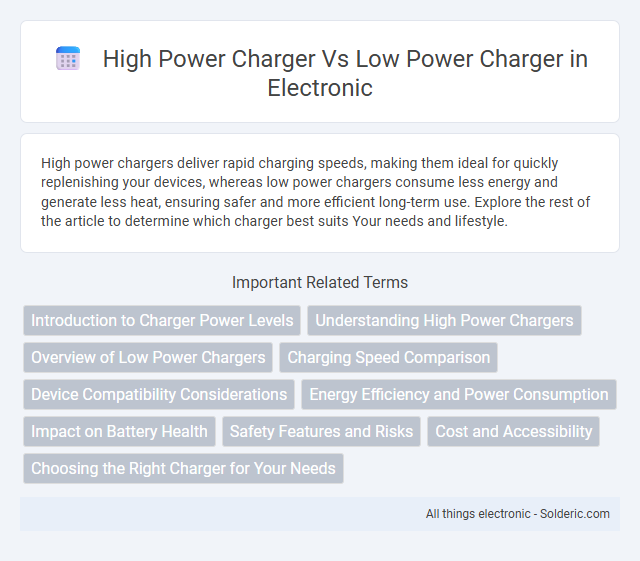High power chargers deliver rapid charging speeds, making them ideal for quickly replenishing your devices, whereas low power chargers consume less energy and generate less heat, ensuring safer and more efficient long-term use. Explore the rest of the article to determine which charger best suits Your needs and lifestyle.
Comparison Table
| Feature | High Power Charger | Low Power Charger |
|---|---|---|
| Charging Speed | Fast charging, typically 50W and above | Slow charging, usually under 20W |
| Use Case | Quick top-ups, compatible with high-capacity batteries | Overnight or low-urgency charging |
| Heat Generation | Higher heat output; requires cooling | Lower heat output; minimal heat management |
| Size and Portability | Larger and heavier | Compact and lightweight |
| Cost | Generally more expensive | More affordable |
| Device Compatibility | Supports fast charge-enabled devices | Works universally, but slower on all devices |
| Battery Health Impact | May reduce battery lifespan if used excessively | Gentler on battery, extends battery health |
Introduction to Charger Power Levels
High power chargers deliver rapid energy transfer, typically exceeding 50 watts, enabling faster device charging compared to low power chargers, which usually range below 20 watts. High power chargers are ideal for smartphones, laptops, and electric vehicles requiring quick replenishment of battery capacity. Your choice between these depends on device compatibility and charging speed preferences.
Understanding High Power Chargers
High power chargers deliver significantly higher wattage, often exceeding 50 watts, enabling faster charging times for devices such as smartphones, laptops, and electric vehicles. These chargers utilize advanced technologies like USB Power Delivery (PD) and GaN (Gallium Nitride) semiconductors to enhance efficiency and reduce heat. In contrast, low power chargers typically provide 5 to 18 watts, suitable for slower, everyday charging needs but less efficient for quick energy replenishment.
Overview of Low Power Chargers
Low power chargers typically deliver between 5W and 18W, making them ideal for slowly charging devices such as smartphones, Bluetooth earbuds, and fitness trackers. These chargers are energy-efficient and generate less heat, reducing wear on your battery and extending device lifespan. Low power chargers are perfect for overnight charging or maintaining battery levels without the risk of overheating or overcharging.
Charging Speed Comparison
High power chargers significantly reduce charging time by delivering higher wattage, often ranging from 30W to over 100W, enabling devices to reach full charge in under an hour. Low power chargers typically provide between 5W and 15W, resulting in slower charging speeds that can take several hours for the same battery capacity. This stark difference in wattage and charging technology directly impacts user convenience and device efficiency.
Device Compatibility Considerations
High power chargers deliver faster charging speeds but may not be compatible with all devices, especially older models that lack the necessary power management protocols. Low power chargers provide safer compatibility across a wider range of devices, reducing the risk of overheating or battery damage. Understanding your device's power requirements ensures you select a charger that optimizes charging efficiency without compromising battery health.
Energy Efficiency and Power Consumption
High power chargers deliver rapid charging by supplying higher wattage, but they generally consume more energy, sometimes leading to reduced overall energy efficiency compared to low power chargers. Low power chargers operate at lower wattages, resulting in slower charging times but often better energy efficiency and less power wastage during the charging cycle. Optimizing charger choice based on device requirements can minimize power consumption and enhance sustainable energy use.
Impact on Battery Health
High power chargers deliver rapid energy transfer that can increase battery temperature and accelerate chemical degradation, potentially reducing your battery's overall lifespan. Low power chargers operate more gently, maintaining lower temperatures and preserving the battery's health by minimizing stress during charging cycles. Choosing the right charger balances charging speed with long-term battery longevity to optimize device performance.
Safety Features and Risks
High power chargers typically include advanced safety features such as overcurrent protection, thermal regulation, and short-circuit prevention to handle increased electrical loads safely. Low power chargers generally pose fewer risks due to their lower energy output but may lack some sophisticated safety mechanisms found in high power models. Choose your charger based on your device's power requirements, ensuring it includes the necessary safety certifications to minimize fire hazards and electrical damage.
Cost and Accessibility
High power chargers generally have a higher upfront cost due to advanced technology and increased electrical capacity, making them less accessible for average consumers or those with limited infrastructure. Low power chargers offer a more affordable entry point and are widely available, suitable for everyday use and locations with standard electrical setups. The balance between cost and accessibility plays a critical role in choosing the right charger for specific device requirements and user environments.
Choosing the Right Charger for Your Needs
High power chargers deliver faster charging speeds by providing higher wattage, ideal for electric vehicles and devices requiring quick energy replenishment, whereas low power chargers offer slower, more gradual charging suited for smaller electronics or overnight use. Selecting the right charger depends on device compatibility, charging time requirements, and energy efficiency preferences. Prioritize a high power charger for rapid charging scenarios and a low power charger to preserve battery longevity and reduce energy consumption.
High power charger vs low power charger Infographic

 solderic.com
solderic.com